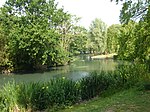Edmonton is an area in north London, England within the London Borough of Enfield. The northern part of the town is known as Edmonton Green or Lower Edmonton, and the southern part as Upper Edmonton. Situated 8.4 miles (13.5 km) north-northeast of Charing Cross, it borders Ponders End and Bush Hill Park in Enfield to the north, Chingford to the east, and Tottenham to the south, with Palmers Green and Winchmore Hill to the west. The population of Edmonton was 82,472 as of 2011.
Edmonton is within the London Borough of Enfield, a local government district of Greater London. Historically a parish in the Edmonton Hundred of Middlesex, Edmonton became an urban district in 1894, and a municipal borough in 1937. Local government took place at the now-demolished Edmonton Town Hall in Fore Street between 1855 and 1965. In 1965, following reform of local government in London, the municipal borough and former parish of Edmonton was abolished, merging with that of Enfield and Southgate to form the new local government district of Enfield, a borough of Greater London.
Once a rural village, the opening of the railway and tramway in the 19th century, especially the opening of the high-level station at Lower Edmonton, caused the area to expand rapidly, forming part of the metropolitan and urban area of London, similar to much of the county of Middlesex. The late 19th century saw the establishment of industry on former marshland and movement of a working-class population to the area, encouraging much of this development. By the 1930s, the area had become a popular north London shopping destination, and in the 1960s and 1970s, the area underwent major redevelopment, with the construction of an indoor market and shopping centre, as well as mass construction of council housing, including tower blocks. In recent years, as a result of increased levels of immigration, the town has been transformed from a predominantly white area into one of the most ethnically diverse areas in England, with the majority of the population now belonging to an ethnic minority background, as first recorded in the 2011 census.
In 1795, the town gave its name to Fort Edmonton, which grew and evolved into the city of Edmonton, the capital city of Alberta, Canada.










